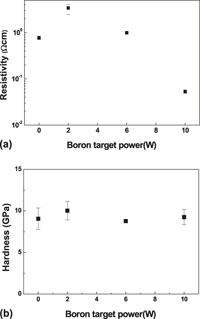Article contents
Compensation effect of boron and nitrogen codoping on the hardness and electrical resistivity of diamond-like carbon films prepared by magnetron sputtering deposition
Published online by Cambridge University Press: 31 October 2012
Abstract

Nitrogen (N) and boron (B) codoped diamond-like carbon (DLC) films were prepared on silicon oxide substrates by RF magnetron sputtering to optimize the electrical conductivity and hardness of DLC film. The electrical conductivity and hardness of the N–B codoped DLC films were controlled simultaneously by varying N2 flow rate with fixed B target power and varying B target power with fixed N2flow rate. The electrical resistivity of the B-doped DLC films showed a cup-shaped relationship with B target power and a U-shaped relationship with the N–B codoped DLC film. However, hardness of the B-doped DLC films showed a decreasing behavior but it was maintained almost constant for the N–B codoped DLC film. These particular electrical and hardness behaviors of the N–B codoped DLC films could be explained by a neutralization effect of N and B codoping.
- Type
- Articles
- Information
- Copyright
- Copyright © Materials Research Society 2012
References
REFERENCES
- 5
- Cited by




